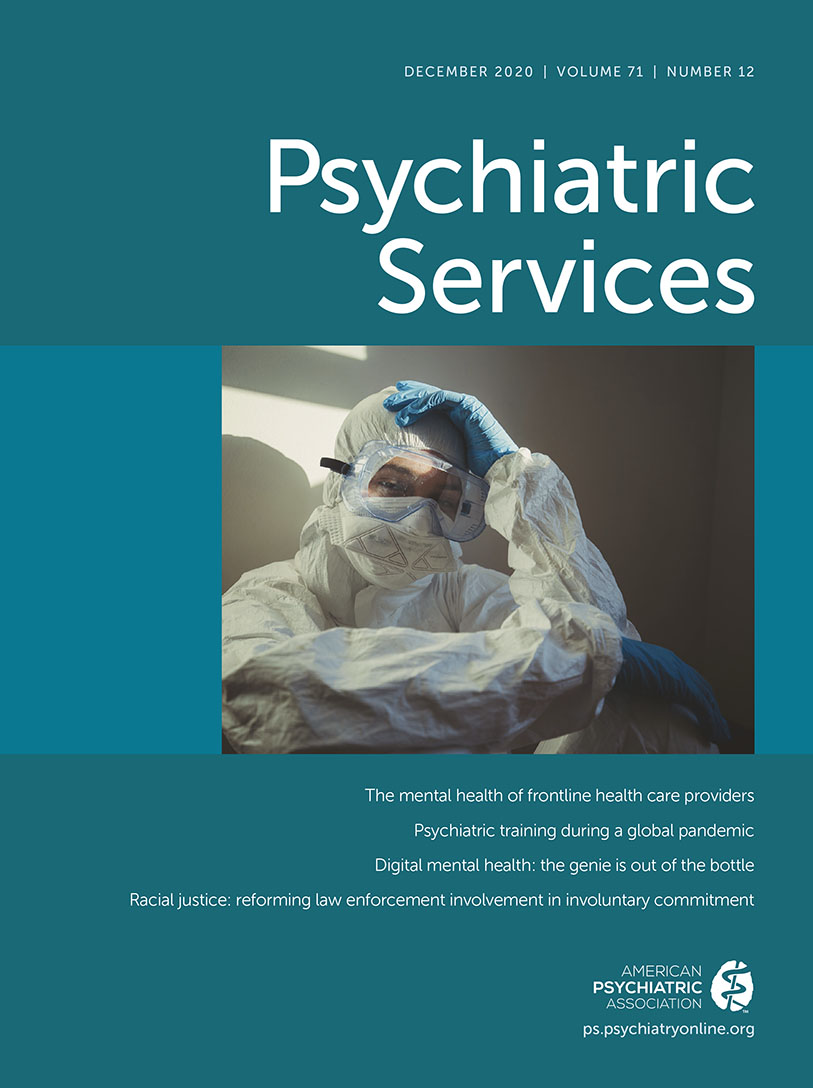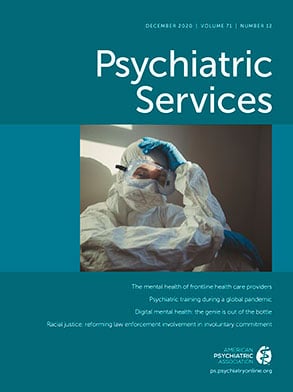The description of the COVID-19 crisis and its migration from Wuhan, China, to the United States has been well documented in countless articles. The spread of the virus has been ubiquitous in populations throughout the world (
1). People in confined settings, such as prisons and long-term care facilities, have been identified as particularly at-risk populations (
2,
3). Furthermore, recent studies have shown that individuals with COVID-19 who are not yet exhibiting symptoms, and even those who never exhibit symptoms, are able to spread the disease (
4,
5). As a result of close-quarter housing and asymptomatic transmission, in addition to patient characteristics that make transmission more likely, psychiatric hospitals are particularly vulnerable (
6). The focus of this study was to explore the transmission of COVID-19 in a psychiatric inpatient setting, where initial Centers for Disease Control and Prevention (CDC) guidelines were followed.
This study was conducted in a remote psychiatric hospital in the South serving approximately 700 patients. Patients are committed to the hospital by court order because of mental illness and significant legal charges that would lead them to become a danger to the community at large. As such, patients are not easily discharged into the community. The hospital’s units are close quarters with shared restrooms. Twenty to 24 patients are housed on a single unit, and buildings consist of four units.
As the COVID-19 crisis started to infect the U.S. population, the executive team of the hospital began preparing for housing, isolation units, step-down units, and personal protective equipment (PPE) and began halting admissions and discharges. The hospital followed CDC guidelines regarding screening patients and staff in anticipation of the potential impact of COVID-19 on this large mental health population and the equally large staff. All off-campus appointments and new admissions were stopped on March 12, 2020. Beginning on March 13, 2020, all staff were screened with the standard screening questions and temperature checks upon entering the campus. At that time, no patients or staff tested positive or reported common COVID-19 symptoms.
A building was identified that was suitable for isolation, step-down-positive, and step-down-negative patients. Staff were trained to use PPE, including donning and doffing, and to practice isolation techniques. Patients were screened for COVID-19 upon becoming symptomatic (temperature >100.4°F), and those with temperatures of >99.5°F and <100.4°F were monitored for further symptoms. New-onset cough, diarrhea, respiratory complaints, and <93% oxygen saturation were checked on all patients suspected to have symptoms. These patients were rapidly moved to the isolation unit pending test results. A step-down-positive unit was positioned beside the isolation unit in the same building. Patients with negative results were housed on a step-down unit awaiting return to their normal units.
All processes, policies, and procedures were established by a leadership team comprising hospital leaders, state epidemiologists, CDC subject matter experts, and Tulane University infectious disease and epidemiology experts. No decisions were made without general agreement of plans as they emerged.
Patient zero was identified as symptomatic with COVID-19 on March 23, 2020, was tested the next day, and received a positive result on March 26, 2020. Despite the use of rapid isolation, proper PPE, and other measures, individuals in the building where patient zero was housed (building zero) rapidly became infected. Transmission was evident before testing was returned from state lab analysis. When a quarter of the patients on the same unit as patient zero were affected, a decision was made by leadership to shelter in place in building zero. Staff were assigned to this building and were not allowed to work in other buildings. Food was dropped off, and routine lab draws were curtailed or performed outside of the building. All psychiatric and social work visits were performed with telemedicine.
The decision for all patients and staff to wear PPE was made on April 3, 2020, with consensus by a CDC subject matter expert and state epidemiologists. Testing by the state was being reserved for symptomatic patients, which was appropriate at the time. The primary author (J.W.T.) became aware that Tulane University School of Medicine was developing a testing procedure to help increase testing volume. When this testing became available, the author saw an opportunity to test a significant sample of individuals from building zero to determine the penetrance of the virus in that building. Testing was done in consultation with the executive leadership and state epidemiologists and with lab assistance from Tulane. The purpose of this sample was to determine the penetrance of asymptomatic and symptomatic patients in building zero. These data, in conjunction with data on patients’ course of illness, had the potential to warn state officials and hospitals in the catchment area of potential future needs, such as hospital beds and burden on the intensive care unit.
Methods
This study was reviewed by the Tulane University institutional review board and determined to be exempt. Existing, deidentified data analyzed in this study included 160 COVID-19 tests collected from patients in an inpatient psychiatric hospital between March 14 and April 8, 2020. Sixty-eight tests of symptomatic patients were collected using state labs. The Tulane University School of Medicine lab provided an additional 92 tests for a sample of asymptomatic patients by using a CDC 2019 novel coronavirus (2019-nCoV) real-time reverse transcription–polymerase chain reaction (RT-PCR) diagnostic panel (
7). By the time the 92 additional patients were tested between April 2 and April 4, 2020, three had become symptomatic, 19 were mildly symptomatic, and 70 remained asymptomatic. Of the 92 additional tests, 41% (N=38) were performed on the remaining patients in building zero who had not yet been tested. The other 59% (N=54) were performed on a random sample of asymptomatic patients throughout three other buildings in the hospital where transmission had recently begun. Patients were randomly selected for testing, excluding those who had already been tested and ensuring that at least one patient was chosen from each unit of the buildings. Analyses were conducted using SPSS, version 24.
Results
A majority of patients in this study were male (N=113, 71%), with a mean±SD age of 51.27±13.91 years (range 23.74–76.36). Two-thirds (N=106, 66%) identified as Black, 33% (N=53) as white, and 1% (N=1) as Hispanic. Results from all 160 tests are presented in
Table 1. The positive-to-negative ratio (51:14) of building zero equates to the alarmingly high rate of 78% positive COVID-19 results among clients with valid test results. The positive-to-negative ratio (28:57) of the other buildings sampled showed a much lower rate of positive tests, at 33%. When we examined the 150 valid test results (excluding 10 pending), a chi-square test (with Yates’s continuity correction) indicated that those in building zero were significantly more likely to test positive than were those in other buildings (χ
2= 28.82, df=1, p=<0.001, ϕ=0.45).
The subset of 67 tests of asymptomatic patients who had valid test results (excluding three pending) was further examined. A chi-square test (with Yates’s continuity correction and Fisher’s exact test) indicated that those in building zero were significantly more likely to test positive than were those in other buildings (χ2= 29.84, df=1, p<0.001, ϕ=0.71).
Discussion
These are preliminary data from testing conducted on symptomatic and asymptomatic patients in a state psychiatric hospital where the COVID-19 virus has spread rapidly despite substantial preparation and use of up-to-date CDC guidelines. Results demonstrate that many asymptomatic or mildly symptomatic patients were positive for COVID-19. It appears that CDC guidelines were not sufficient for containing spread in these close-quarter settings.
Although physical distancing is recommended for limiting the spread of COVID-19, such distancing is not possible in close-quarter, confined settings. As such, some state prisons and county jails have decreased bail or released inmates early to decrease spread of the virus. However, given the nature of the offenses of patients in long-term psychiatric settings, combined with their high need for care, releasing patients is not a feasible option. Use of field tents may be a solution for decreasing crowding and increasing physical distance; however, this is not possible in all settings.
Given the difficulties with physical separation, additional measures, such as universal masking, must be taken. Because of the high number of asymptomatic and mildly symptomatic patients who tested positive in this study, waiting to implement masking until the first symptomatic patient tests positive is not recommended. Of course, the limited availability of PPE must be taken into consideration. Another possible preventative measure is to test all staff members who have contact with patients, whether or not they are showing common COVID-19 symptoms. It is possible that asymptomatic staff members may play a role in the introduction or spread of the virus. Unfortunately, with limited testing available, tests are typically reserved for symptomatic patients and staff.
Although the exact source of COVID-19 in the hospital in this study is unknown, hospital administrators suspect that either an asymptomatic staff member introduced the virus or that patient zero was exposed during an off-campus medical appointment that occurred 12 days before he or she became symptomatic and just 1 day before all off-campus appointments were cancelled.
The ability to test asymptomatic patients was a strength of this study and allowed for an estimate of asymptomatic transmission of COVID-19 in close-quarter settings. However, the results should be interpreted with the study’s limitations in mind. Because of limited available testing, not all patients in the hospital were able to be tested. Thus, the penetrance rates provided are estimates based on subsamples.
Conclusions
It is recommended that all close-quarter psychiatric facilities consider using universal masking prior to discovering the initial case of COVID-19. Waiting for positive test results may result in rapid infection by symptomatic and asymptomatic infected patients.
Acknowledgments
The authors appreciate the assistance of Robert Garry, Ph.D., professor of microbiology and immunology at Tulane University School of Medicine, and of Xiao-Ming Yin, M.D., Ph.D., professor and chair of pathology and laboratory medicine at Tulane University School of Medicine, who facilitated and coordinated testing.

